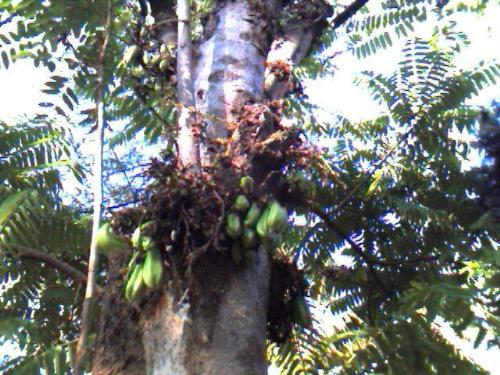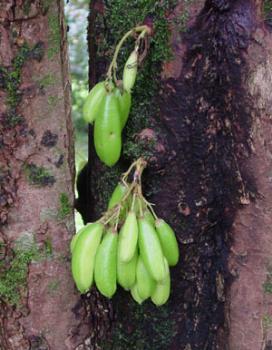Can you Identify the plant shown in the photo?
By Geoas
@ashjoe76 (1422)
India
February 1, 2007 3:34pm CST
I would be grateful if anyone of you can identify the plant shown in the photo attached here. I know its fruit has a sour taste, but would like to know how it is used for food. It has tiny red flowers as well. I don't know whether that is edible as well. And, if possible, please do give me the name of it, in any of the language you know. Thank you.
2 people like this
6 responses
@samsonskola (3357)
• United States
2 Feb 07
i can't really see the fruit very well, but let me ask you a question...if you slice it does it have the shape of a star? If so, then we call it star fruit here in the US..i know it has another name, too, but i've forgotten it...the star fruit has sort of a sour and sweet taste...like i said, i can't see the fruit very well, but from what i can see, it looks a little like it. Please let me know, or if that's not it, could you post a better pic of the fruit itself? Thanks
@LittleMel (8742)
• Canada
3 Feb 07
I see the picture and from down here it looks like a certain fruit we call Buh-liem-bing in my language. I don't know the English word since it is tropical fruit I have never found it here in Canada.
But this fruit is lighter in color and sweet, not sour. We don't use it for food, just a dessert, mixed with pineaple, apple, mango etc.
I think the fruit in the picture is darker in colour and larger than the fruit I know.
@ashjoe76 (1422)
• India
3 Feb 07
Thanks for your willingness to help dear friend. I would like to know which language you use. I am afraid the fruit you are talking about is different, since this one is sour, for sure:) But, it's nice to know about a similar looking fruit. Please do share your knowledge about it, and it may perhpas help us find out whether it belongs to the same family as star fruit and bilimbi.
@samsonskola (3357)
• United States
3 Feb 07
Hey, take a look at this pic, I think it's a Bilimbi...a genus of the star fruit, but they say this one is more acidic ....let me know if this is it.
@samsonskola (3357)
• United States
4 Feb 07
I managed to find some very interesting information regarding this fruit. I've learned a lot new from researching this. I didn't realize just what all this plant could do....hope this helps......
Too sour to be eaten raw, the uncooked bilimbi is prepared as relish and served with rice and bean in Costa Rica. In the Far East, where the tree originates, it is sometimes added to curry. Bilimbi juice (with a pH of about 4.47) is made a cooling beverage. It can replace mango in making chutney.
Besides, the fruit can be preserved, which reduces its acidity. The flowers are also sometimes preserved in sugar.
The bilimbi is generally regarded as too acid for eating raw, but in Costa Rica, the green, uncooked fruits are prepared as a relish which is served with rice and beans. Sometimes it is an accompaniment for fish and meat. Ripe fruits are frequently added to curries in the Far East. They yield 44.2% juice having a pH of 4.47, and the juice is popular for making cooling beverages on the order of lemonade.
Mainly, the bilimbi is used in place of mango to make chutney, and it is much preserved. To reduce acidity, it may be first pricked and soaked in water overnight, or soaked in salted water for a shorter time; then it is boiled with much sugar to make a jam or an acid jelly. The latter, in Malaya, is added to stewed fruits that are oversweet. Half-ripe fruits are salted, set out in the sun, and pickled in brine and can be thus kept for 3 months. A quicker pickle is made by putting the fruits and salt into boiling water. This product can be kept only 4 to 5 days.
The flowers are sometimes preserved with sugar
Medicinal Uses: In the Philippines, the leaves are applied as a paste or poulticed on itches, swellings of mumps and rheumatism, and on skin eruptions. Elsewhere, they are applied on bites of poisonous creatures. Malayans take the leaves fresh or fermented as a treatment for venereal disease. A leaf infusion is a remedy for coughs and is taken after childbirth as a tonic. A leaf decoction is taken to relieve rectal inflammation. A flower infusion is said to be effective against coughs and thrush.
In Java, the fruits combined with pepper are eaten to cause sweating when people are feeling "under the weather". A paste of pickled bilimbis is smeared all over the body to hasten recovery after a fever. The fruit conserve is administered as a treatment for coughs, beri-beri and biliousness. A sirup prepared from the fruit is taken as a cure for fever and inflammation and to stop rectal bleeding and alleviate internal hemorrhoids.
@ashjoe76 (1422)
• India
3 Feb 07
Yes Samson, that's exactly the fruit I meant. Thanks a lot for finding out its English name for me! Thank you also to the friend who has given another name for it. Now, my second concern is - how do we use/process it? You have any idea, friends? eaten raw? pickles? Added as a flavour? made in a dish? please help.

@GardenGerty (166771)
• United States
2 Feb 07
Hi, I agree with the other response that this looks like star fruit, also known as carombola. I did flip over to a website and look at some foliage on carombola that definitely was similar.When this fruit is somewhat soft, yet still firm, peel just the tiniest edge off of each point of the star. Slice it crosswise and eat it. My kids really liked it when we could get this fruit in the stores. I think it is distantly related to a plum.
@yanjiaren (9031)
•
2 Feb 07
how de we see the photo? cos i come straight here from my email alert and i can't see the photo..only the word sour fruit lol











